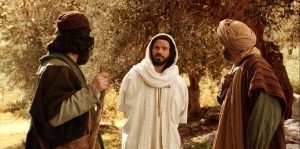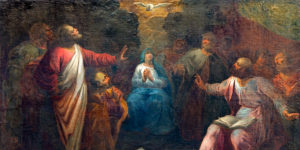Reading the gospel, sometimes a sentence, even a single word, can keep us… there –
at the thought, or the scene, or… more still, at the situation described.
We may not be fully aware of the reason, but we are drawn to remain… just there.
We feel the need to see more, understand more deeply, realize…
Yes, realize that what is described, in a given text, is very close to our own experience.
This could be said of what today’s gospel says of the two disciples on the road to Emmaus (Luke 24:13-35):
 “Something prevented them from recognizing him.”
“Something prevented them from recognizing him.”
Of course, we wonder… what is this something?
Why is it that, while Jesus is walking with them, the two men fail to recognize him?
The two disciples see, but they do not perceive…
Their minds are puzzled, they fail to understand…
Their hearts grieve, they are unaware of the reality…
Pursuing our reflection, we may look… inwards… and ask ourselves:
What is it that prevents US from recognizing the Lord walking with us – for he does!
We are often confused by what happens to us.
We are bewildered by the situations we find ourselves in.
We grieve, we lament, we are sad and downcast.
And… we do not dare to hope, we do not dare to BELIEVE, so we fail to see…
We do not recognize ‘God-with-us’ – the very name given to Jesus: ‘Emmanuel’ – walking with us.
Until… Until when?…
Until God becomes really real for us!
Note: In the following video, Anil Das Kumar and Dominic Savio Rassalayyan, who personify the disciples of Emmaus, tell us what happened on that night as they were on the way: https://youtu.be/4QwKU442-80
Another text is available on a different theme, in French at: https://image-i-nations.com/3e-dimanche-de-paques-annee-a-2023/
Source: Image: https://www.churchofjesuschrist.org/
 We celebrate International Artist Day on October 25. Art as a creative human expression encapsulates myriad things. It portrays the beauty of life or a bitter reality. It records history, revolutions, rebellions, and sometimes is a means to escape them. In short, there is no history or culture without art. This day celebrates all forms of art — paintings, sculpture, photography, architecture, music, and more. Through this celebration we show our respect for the passion and creativity in all artists. As art provide you with a medium of speech let us also see the work of those artists who study, research and criticize artists to showcase their art of words, here is a list of
We celebrate International Artist Day on October 25. Art as a creative human expression encapsulates myriad things. It portrays the beauty of life or a bitter reality. It records history, revolutions, rebellions, and sometimes is a means to escape them. In short, there is no history or culture without art. This day celebrates all forms of art — paintings, sculpture, photography, architecture, music, and more. Through this celebration we show our respect for the passion and creativity in all artists. As art provide you with a medium of speech let us also see the work of those artists who study, research and criticize artists to showcase their art of words, here is a list of  At the mention of Palm Sunday, the scene immediately comes to mind (Mark 11:1-10).
At the mention of Palm Sunday, the scene immediately comes to mind (Mark 11:1-10). “A sound like the blowing of a violent wind came from heaven;
“A sound like the blowing of a violent wind came from heaven;


 “The sun of righteousness will shine with healing in its rays.”
“The sun of righteousness will shine with healing in its rays.”